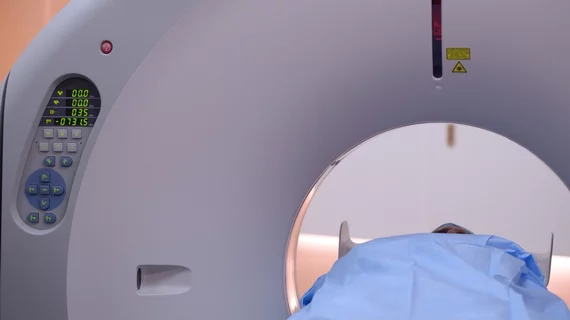CT analysis prior to percutaneous pulmonary valve implantation (PPVI) in patients with congenital heart disease (CHD) could help physicians detect which individuals are at the greatest risk for coronary artery compression (CC) during the procedure, according to research published ahead of print in the European Journal of Radiology.
PPVI—a nonsurgical option for treating right ventricular outflow tract (RVOT) dysfunction in patients with CHD—isn’t usually those patients’ first cardiac procedure, first author Michela Tezza and colleagues at Erasmus Medical Center in Rotterdam, the Netherlands, wrote in the journal. Those with CHD involving RVOT typically undergo multiple corrective surgeries early in life, but they’re often left with pulmonary regurgitation or stenosis years later.
PPVI is a good solution, Tezza et al. said, but it carries a high risk of CC. And, despite the potential utility of cardiac CT in assessing CC risk due to a close relationship between the coronary arteries and pulmonary trunk (PT), no guidelines or data exist surrounding the use of cardiac CT in this setting. Instead, doctors tend to turn to aortic root or selective coronary angiography to avoid CC.
“Noninvasive cardiac CT may be a valuable technique in the pre-procedural workup to identify patients at high CC risk by demonstrating a close relationship of the RVOT with the potential to omit invasive angiography in some patients since they are unlikely to undergo successful PPVI,” the authors wrote. “It may also aid the operator during the procedure by indicating which coronaries need a careful analysis during balloon inflation testing.”
For their work, Tezza and co-authors retrospectively assessed the efficacy of cardiac CT in 52 CHD patients with RVOT issues, measuring the minimum distance between each coronary artery and the part of the PT intended to be the future site of valve implantation. All patients had undergone CT prior to PPVI.
The researchers found that, of 52 patients, 30 underwent PPVI after CT analysis and 22 didn’t. Six high-risk patients avoided the procedure because of a detected risk for CC, but another six deemed at “intermediate CC risk” underwent additional balloon inflation testing and were able to move forward with PPVI. No patients identified as low-risk experienced CC during PPVI.
“In our experience, patients considered at intermediate CC risk both with and without PT stenosis underwent a careful balloon inflation testing prior to PPVI, but this demonstrated no compression of the coronary arteries,” Tezza et al. wrote. “In all patients with low CC risk at CT, the procedure confirmed the absence of coronary compression. In these cases the operator may consider the possibility of omitting the balloon test.”
The authors said a greater number of patients is needed to prove the distance threshold they suggested: high-risk (less than 2 millimeters), intermediate-risk (between 2 and 5 mm) and low-risk (more than 5 mm). They also said future studies are needed to identify more risk factors involved in CC during PPVI.
“CT seems to be able to detect patients at high and intermediate risk of coronary compression and therefore may identify which patients are unlikely to undergo successful PPVI and those who need a careful analysis with balloon testing,” Tezza and colleagues wrote. “CT can also rule out CC risk, identifying those patients in which balloon inflation testing could be omitted.”

